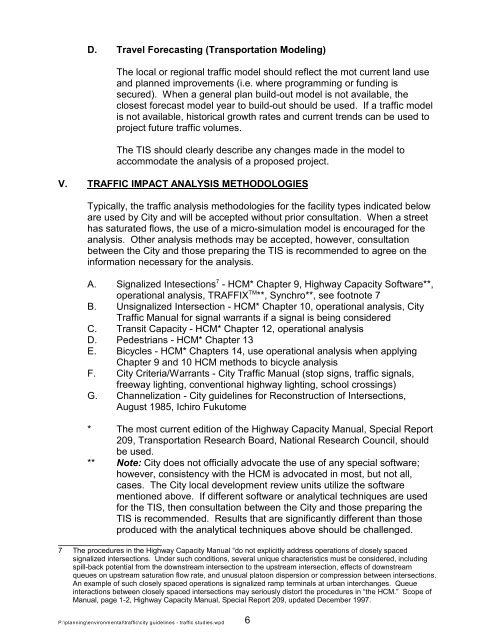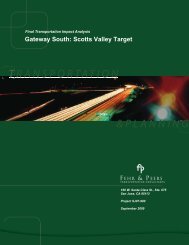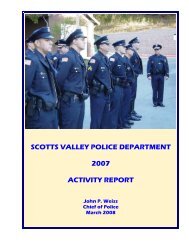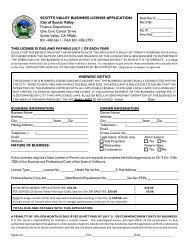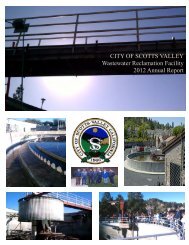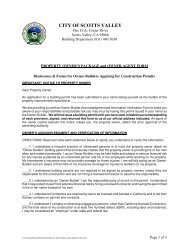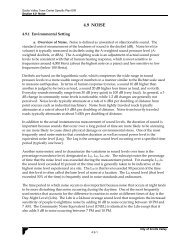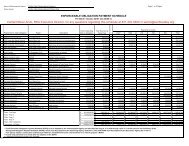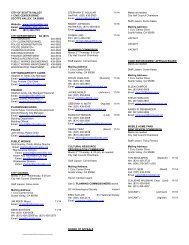Guide to Traffic Impact Study - City of Scotts Valley
Guide to Traffic Impact Study - City of Scotts Valley
Guide to Traffic Impact Study - City of Scotts Valley
You also want an ePaper? Increase the reach of your titles
YUMPU automatically turns print PDFs into web optimized ePapers that Google loves.
D. Travel Forecasting (Transportation Modeling)<br />
The local or regional traffic model should reflect the mot current land use<br />
and planned improvements (i.e. where programming or funding is<br />
secured). When a general plan build-out model is not available, the<br />
closest forecast model year <strong>to</strong> build-out should be used. If a traffic model<br />
is not available, his<strong>to</strong>rical growth rates and current trends can be used <strong>to</strong><br />
project future traffic volumes.<br />
The TIS should clearly describe any changes made in the model <strong>to</strong><br />
accommodate the analysis <strong>of</strong> a proposed project.<br />
V. TRAFFIC IMPACT ANALYSIS METHODOLOGIES<br />
Typically, the traffic analysis methodologies for the facility types indicated below<br />
are used by <strong>City</strong> and will be accepted without prior consultation. When a street<br />
has saturated flows, the use <strong>of</strong> a micro-simulation model is encouraged for the<br />
analysis. Other analysis methods may be accepted, however, consultation<br />
between the <strong>City</strong> and those preparing the TIS is recommended <strong>to</strong> agree on the<br />
information necessary for the analysis.<br />
7<br />
A. Signalized Intesections - HCM* Chapter 9, Highway Capacity S<strong>of</strong>tware**,<br />
TM<br />
operational analysis, TRAFFIX **, Synchro**, see footnote 7<br />
B. Unsignalized Intersection - HCM* Chapter 10, operational analysis, <strong>City</strong><br />
<strong>Traffic</strong> Manual for signal warrants if a signal is being considered<br />
C. Transit Capacity - HCM* Chapter 12, operational analysis<br />
D. Pedestrians - HCM* Chapter 13<br />
E. Bicycles - HCM* Chapters 14, use operational analysis when applying<br />
Chapter 9 and 10 HCM methods <strong>to</strong> bicycle analysis<br />
F. <strong>City</strong> Criteria/Warrants - <strong>City</strong> <strong>Traffic</strong> Manual (s<strong>to</strong>p signs, traffic signals,<br />
freeway lighting, conventional highway lighting, school crossings)<br />
G. Channelization - <strong>City</strong> guidelines for Reconstruction <strong>of</strong> Intersections,<br />
August 1985, Ichiro Fuku<strong>to</strong>me<br />
* The most current edition <strong>of</strong> the Highway Capacity Manual, Special Report<br />
209, Transportation Research Board, National Research Council, should<br />
be used.<br />
** Note: <strong>City</strong> does not <strong>of</strong>ficially advocate the use <strong>of</strong> any special s<strong>of</strong>tware;<br />
however, consistency with the HCM is advocated in most, but not all,<br />
cases. The <strong>City</strong> local development review units utilize the s<strong>of</strong>tware<br />
mentioned above. If different s<strong>of</strong>tware or analytical techniques are used<br />
for the TIS, then consultation between the <strong>City</strong> and those preparing the<br />
TIS is recommended. Results that are significantly different than those<br />
produced with the analytical techniques above should be challenged.<br />
___________________<br />
7 The procedures in the Highway Capacity Manual “do not explicitly address operations <strong>of</strong> closely spaced<br />
signalized intersections. Under such conditions, several unique characteristics must be considered, including<br />
spill-back potential from the downstream intersection <strong>to</strong> the upstream intersection, effects <strong>of</strong> downstream<br />
queues on upstream saturation flow rate, and unusual pla<strong>to</strong>on dispersion or compression between intersections.<br />
An example <strong>of</strong> such closely spaced operations is signalized ramp terminals at urban interchanges. Queue<br />
interactions between closely spaced intersections may seriously dis<strong>to</strong>rt the procedures in “the HCM.” Scope <strong>of</strong><br />
Manual, page 1-2, Highway Capacity Manual, Special Report 209, updated December 1997.<br />
P:\planning\environmental\traffic\city guidelines - traffic studies.wpd<br />
6


